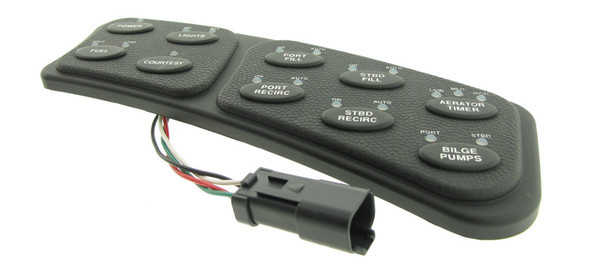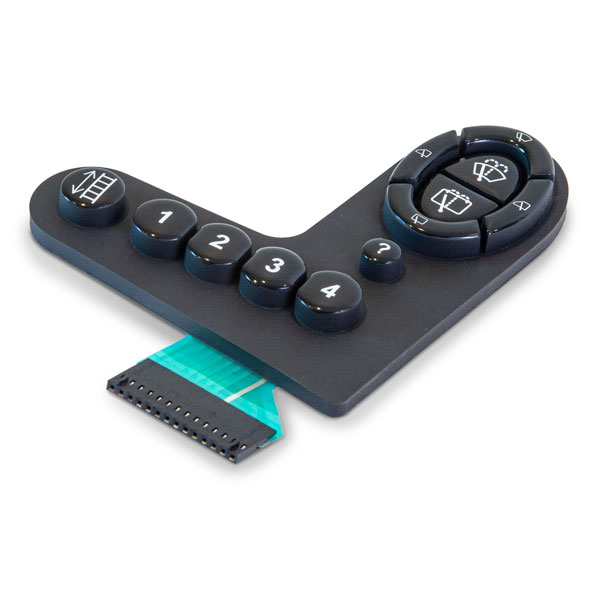Membrane switch and branding: How to align function with form
Wiki Article
All Regarding Membrane Switch Over: A Comprehensive Overview for Beginners
Membrane buttons are essential parts in contemporary electronics, supplying a special interface for customer communication - membrane switch. Their layered building, consisting of overlays and conductive traces, gives capability and resilience. Unlike standard mechanical switches, membrane layer switches offer a sleek layout and personalized alternatives. Comprehending their vital functions and advantages can transform item design. The complexities of their application and layout considerations call for further exploration.What Is a Membrane layer Switch?
A membrane button is a sort of electrical button that contains a flexible membrane layer layered over a published circuit card. This layout allows for a smooth and portable user interface, frequently made use of in various electronic gadgets. Membrane layer switches are typically located in consumer home appliances, clinical tools, and industrial machinery because of their longevity and resistance to environmental factors.The building commonly consists of multiple layers, such as graphic overlays and sticky support, which offer responsive comments and protect the wiring underneath. The operation of a membrane switch is initiated when pressure is related to the surface area, finishing an electric circuit.These switches are valued for their adaptability, making it possible for custom styles and published graphics that satisfy specific individual interfaces. Their inconspicuous nature lowers area needs, making them perfect for applications where standard buttons might not fit. In general, membrane switches use a aesthetic and functional service for modern electronic tools.Trick Elements of Membrane Layer Changes
Membrane switches consist of a number of essential components that add to their capability and efficiency. The top layer, referred to as the overlay, provides the customer interface and is usually published with graphics or signs. Beneath the overlay exists a spacer layer, which separates the conductive elements and protects against unintentional activation. The next vital part is the graphic layer, which enhances visual appeals and guarantees the durability of the design.Conductive traces, commonly made from materials like silver or carbon, are published on the circuit layer. When pressure is applied to the overlay, these traces enter into get in touch with, finishing the circuit. Furthermore, a backing layer supplies architectural support and can be made from products such as polyester or polycarbonate. Together, these parts produce a reliable, straightforward interface ideal for various applications, from house home appliances to commercial equipment. Recognizing these elements is crucial for anyone thinking about membrane layer switch modern technology.How Membrane Layer Switches Work
Recognizing how membrane layer switches over feature is essential for appreciating their prevalent usage in different gadgets. A membrane layer button operates with a collection of layers, consisting of a graphic overlay, spacer, and a circuit layer. When pressure is used to the overlay, it compresses the spacer layer, enabling the circuit layer to make call and finish an electrical circuit. This action sends out a signal to the gadget, prompting an action, such as activating a light or activating a function.Membrane switches can be created with numerous attributes, including tactile comments, backlighting, and custom-made graphics, boosting user interaction. Their building enables for a covered layout, protecting the internal elements from dust, wetness, and pollutants. This longevity makes them suitable for diverse applications, from consumer electronics to industrial equipment. In general, the simplicity and efficiency of membrane switches add to their popularity in modern technology.Advantages of Membrane Layer Switches Over Over Mechanical Buttons
While mechanical buttons have actually long been a staple in several tools, membrane switches over deal distinctive benefits that make them progressively appealing. One considerable benefit is their slim profile, enabling more compact layouts and higher versatility in item advancement. Furthermore, membrane switches attribute a consistent surface, which enhances visual allure and streamlines cleaning, making them suitable for settings where health is critical.Another advantage is their resistance to dust and dampness. Unlike mechanical buttons, which can be jeopardized by environmental variables, membrane layer switches provide a covered user interface that safeguards against impurities - membrane switch. Membrane buttons generally have a longer life-span due to fewer relocating parts, resulting in boosted sturdiness and reliability.Cost-effectiveness is additionally a significant advantage, as membrane buttons can be produced in mass with lower production prices. These aspects combine to position membrane layer buttons as a sensible alternative to typical mechanical choices in various applicationsTypical Applications of Membrane Changes
Membrane layer buttons are widely made use of in various markets, especially in customer electronics and commercial control board. In consumer devices, they give a smooth, user-friendly interface, while in commercial setups, they boost toughness and functionality. Comprehending these applications highlights the convenience and practicality of membrane switches in contemporary innovation.Customer Electronic Devices Devices
As consumer electronics proceed to advance, membrane layer buttons have become a popular option for a range of tools as a result of their versatility and sleek design. These switches are typically discovered in mobile phones, tablets, and push-button controls, where room is minimal and aesthetic appeals matter. Their low profile and adjustable styles enable producers to produce user-friendly interfaces that enhance the overall user experience. In addition, membrane layer buttons are usually made use of in devices such as microwaves and coffee manufacturers, offering intuitive control options while resisting moisture and dust. The longevity and integrity of membrane layer changes make them appropriate for everyday customer items, guaranteeing durability and consistent efficiency. Overall, their combination in customer electronic devices shows a blend of performance and modern-day design.Industrial Control Panels
The applications of membrane layer changes prolong past customer electronics, finding significant usage in industrial control panels. These switches are favored for their sturdiness and resistance to severe environments, making them suitable for making and process control setups. They give a trusted user interface for drivers to regulate equipment, screen procedures, and adjust setups. Membrane layer switches can be personalized to fit particular functional needs, including attributes like backlighting and tactile comments, boosting user experience. Their inconspicuous design enables integration right into various devices, while their capacity to stand up to spills, dust, and extreme temperature levels guarantees long life. Overall, membrane buttons contribute to effective and secure procedure in commercial applications, demonstrating their adaptability and effectiveness sought after settings.Considerations for Designing Membrane Layer Switches Over
When developing membrane layer buttons, picking the right materials is vital to guarantee sturdiness and capability. In addition, understanding layer setup methods can substantially influence the button's performance and user experience. These considerations play a crucial duty in developing dependable and efficient membrane switch styles.
Material Choice Significance
Material selection plays a necessary duty in the style and performance of membrane layer switches. The selected materials directly affect the switch's sturdiness, tactile continue reading this reaction, and total aesthetic. Trick factors to consider consist of the substratum, which have to give architectural stability while allowing for flexibility, and the graphic overlay, which requires to be immune to use and environmental factors. Conductive products need to ensure trustworthy electrical performance, while adhesives must supply solid bonding without jeopardizing the switch's procedure. In addition, compatibility with making processes and end-user atmospheres is important; products need to hold up against differing temperatures, humidity degrees, and chemical exposure. Inevitably, proper material choice not only enhances the membrane button's performance but also adds to its durability and customer contentment, making it a crucial facet of the style process.
Layer Configuration Strategies

Often Asked Inquiries
How Much Time Do Membrane Layer Switches Over Commonly Last?
Membrane switches generally have a lifespan of 1 to 5 million cycles, relying on use and environmental conditions. Factors such as style quality and operating regularity greatly affect their toughness and total performance long life.
Can Membrane Layer Switches Over Be Custom-made for Details Layouts?
Membrane switches can indeed be customized to suit details styles, permitting diverse shapes, shades, and capabilities. This adaptability allows manufacturers to customize these buttons to satisfy unique visual and operational requirements properly.What Products Are Used in Membrane Layer Change Construction?
Membrane layer switches are typically built using products such as polyester, polycarbonate, and adhesive layers. These materials give resistance, sturdiness, and versatility to ecological elements, guaranteeing the switches function effectively in various applications and problems.
Are Membrane Layer Changes Water Resistant or Resistant to Moisture?
Membrane layer buttons can be designed to be moisture-resistant, utilizing specialized materials and finishings. Their waterproof capabilities depend on building and construction top quality and details applications, making it vital to analyze demands for excellent performance in numerous settings.Just How Are Membrane Layer Switches Over Fixed if Harmed?
Repairing damaged membrane switches typically involves changing the influenced layer or circuit. Professionals might likewise apply conductive adhesive or use specialized repair packages, making certain capability is brought back without total replacement of the whole button assembly. Unlike conventional mechanical switches, membrane layer switches present a streamlined layout and adjustable options. A membrane layer button is a type of electric button that consists of an adaptable membrane layer layered over a printed circuit board. The procedure of a membrane layer switch is launched when pressure is applied to the surface area, completing an electric circuit.These buttons are valued for their flexibility, making it possible for custom-made designs and published graphics that cater to specific customer interfaces. While mechanical switches have actually long been a staple in numerous tools, membrane layer switches deal distinct benefits that make them progressively appealing. Membrane layer switches typically have a longer life expectancy due to fewer relocating parts, resulting in improved resilience and reliability.Cost-effectiveness is additionally a significant advantage, as membrane buttons my latest blog post can be created in mass with lower production costs.Report this wiki page